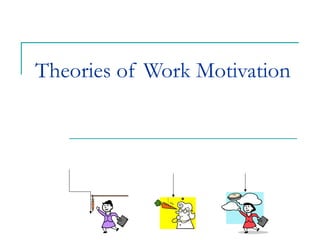
Theories of Work Motivation Explained
- 1. Theories of Work Motivation
- 2. Work Motivation Work motivation is a process to energize employee to the work goal through a specific path.
- 4. The process theories :- 1.) Vroom’s Expectancy Theory Also known as VIE Theory According to this theory, an employee will work smarter and/or harder if he believes his additional efforts will lead to valued rewards.
- 5. VIE Theory Valence refers to the emotional orientations people hold with respect to outcomes [rewards]. Instrumentality: The perception of employees whether they will actually get what they desire even if it has been promised by a manager. Expectancy: Employees have different expectations and levels of confidence about what they are capable of doing. Motivation = ValanceXExpectancyX(Instrumentality)
- 7. Expectancy Theory Value of reward Perceived Abilities Equitable & Rewards Traits Intrinsic Rewards Satisfaction Effort Performance Extrinsic Rewards Role perceptions Perceived effort Probability of reward
- 8. 2.) Porter Lawler Model Tried to explore the complex relationship between motivation, satisfaction and performance and pointed out the efforts put in by an employee did not directly result in performance. It can be considered as the extended version of vroom’s theory.
- 10. Performance is dependent on: Employee desire to perform Ability and skills Clear perception of role
- 11. Important variables: Effort Performance Rewards Satisfation
- 13. 1.) Equity Theory The degree of equity or inequity perceived by an employee with reference to his work situation plays a major role in work performance and satisfaction. EQUITY: Person’s outcome = other’s outcome person’s inputs other’ inputs
- 15. Attribution Theory It identifies attributions made by people as the basis for their motivation. Attribution theory is concerned with how individual interpret events and how this is related to their thinking and behavior. This theory describes how people explain, justify, and/or provide excuses about influences on their motivation.
